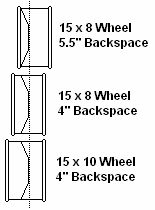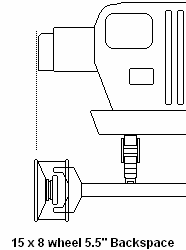
|
|||
|
Jeep FAQ How-To Articles Quick Reference Product Reviews My Buildup Random Home |
This writeup is meant to be basic wheel tech writeup. Generally you have two choices in wheels steel or aluminum (yes I know magnesium wheels are an option, but not for off-roaders). Steel wheels are generally cheaper, easier to repair, can be more durable, and hold up to rock rash much better than an aluminum wheel. Aluminum wheels on the other hand, do tend to look better, come in a wide variety of styles, and in many cases are lighter. So an aluminum wheel is an aluminum wheel right? Not quite, there's actually a big difference in types of aluminum wheels. The two main types of aluminum wheels are cast or forged. The majority of aluminum wheels out there today are cast. Cast tends to be weaker, heavier, and tend to crack or shatter rather than bend when impacted. Cast wheels are by far easier to make, so they tend to be cheaper, and the main reason they are so popular. A forged wheel is generally created from a large chunk of aluminum (the center section is a seperate piece), and is formed under 4000+ tons of pressure to help ensure the grain structure of the aluminum is very tight. Forged wheels for this reason are night and day stronger, using less material (less weight), and will tend to bend rather than crack when impacted. For the most part a steel wheel is a steel wheel. They are just pieces of shaped steel welded together. Since there is no casting or forging required, steel wheels are cheap pricewise, and a great choice for many fourwheelers. Steel wheels for the most part won't ever crack, at the very worst you could bend one, which can easily be fixed by a wheel shop. A steel wheel won't mind being drug across a rock, and you fix it cosmetically with some spray paint. Now for the weight issue. A forged aluminum wheel can be half of the weight of a steel wheel. That could be 50+ pounds of un-sprung weight you are losing (50 total all 4 wheels combined), which would definitely be a huge difference. However with a cast wheel things are pretty different. In many cases a cast wheel is barely lighter than most steel wheels, in some cases if you save 15 pounds total, you've done good. I've seen some cast aluminum wheels that are actually heavier than steel wheels. Now I'm not saying all cast wheels are roughly the same weight as a steel wheels, just if you are going for weight savings, you better find out how much the wheels you are looking for actually weigh. Backspacing seems to be where most people get confused. Backspacing is the measurement of how far in the wheel mounting surface is. In the picture below, a backspace or offset measurement would be taken where the arrow is.  Backspace controls how far in or out a wheel sticks. Now if you compare a 15x8 and 15x10 wheel both a 4" backspace the 15x10 wheel is going to stick out farther. On the 15x8 wheel you have 4" behind the wheel mounting surface, and 4" in front of it, but, on the 15x10 wheel you have 4" behind the wheel mounting surface and 6" in front of it.  To help demonstrate the effect of wheel width and backspacing better, I've created this animation:  So now for wheel sizes. Most people choose 15" wheels as you have more tire options and typically they are cheaper pricewise. So now 8" wide, 10" wide, 12" wide, whats the right width? Simple answer, follow Kwrangln's general rule of thumb, off-road performance subtract 4" from the tire width, on-road performance subtract 2" from the tire width. So using kwrangln's rule for offroad performance, 12" wide tire - 4" = 8" wide wheel. For on road use 12 wide tire - 2" = 10" wide wheel. However there's more to it than that. Typically like the narrower wheels on the wider tires to help keep the bead seated when air-down off road. The wheel is also a little more protected by the tire. However on the downside, the narrower wheel requires that you run less air pressure to achieve even tire wear. The wider wheel will give you a wider stance which is more stable, and allows you to run more air pressure on the road and still achieve even tire wear. There's pros and cons to either, so you'll have to decide whats most important to you. Also see: What size wheel should I run? If you are looking for some information about beadlocks, check out my beadlock writeups:
© Copyright 2006 - 2024 Mike Lee
|
|
|